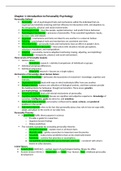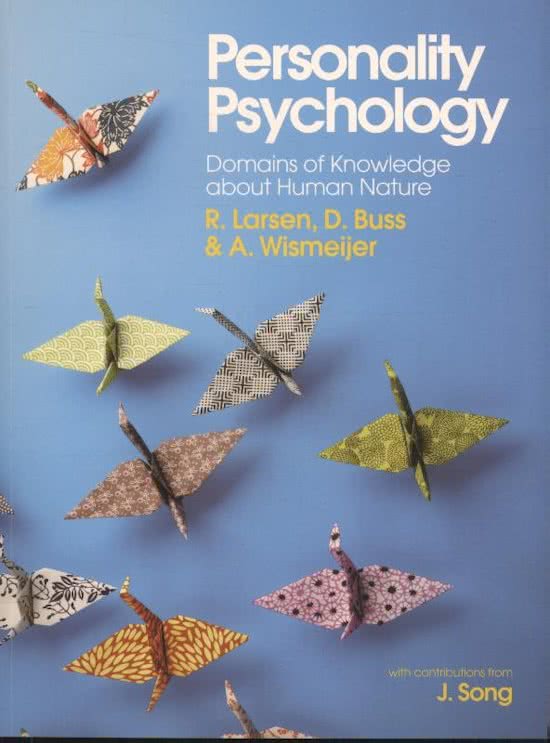Chapter 1: Introduction to Personality Psychology
Personality Defined
Personality = set of psychological traits and mechanisms within the individual that are
organized and relatively enduring and that influence his interactions with, and adaptions to,
the intrapsychic, physical, and social environments.
Psychological traits = describe people, explain behaviour, and predict future behaviour.
Psychological mechanisms = processes of personality. Three essential ingredients: inputs,
decision rules and outputs.
Organized = mechanisms and traits are linked to one another in a coherent fashion.
Enduring = psychological traits and mechanisms are consistent over time.
Influential forces = personality traits and mechanisms have an effect on people’s lives.
Person-environment interaction = interactions with situations include perceptions,
selections, evocations, and manipulations.
Adaption = personality concerns adaptive functioning (coping, adjusting, accomplishing).
Environment = intrapsychic, physical, and social environment.
Three Levels of Personality Analysis
Human nature
o Nomothetic research = statistical comparisons of individuals or groups.
Individual and group differences
Individual uniqueness
o Idiographic research = focuses on a single subject.
Six Domains of Knowledge about Human Nature
Domain of knowledge = delineates the boundaries of researchers’ knowledge, expertise and
interests.
Dispositional domain deals with ways in which individuals differ from one another.
Biological domain: humans are collections of biological systems, and these systems provide
the building blocks for behaviour, thought and emotion. Three areas: genetics,
psychophysiology, and evolution.
Intrapsychic domain deals with mental mechanisms of personality.
Cognitive-experiential domain focuses on cognition and subjective experience. Knowledge of
ourselves, intelligence, goals we strive for, and emotions.
Social and cultural domain: personality is influenced by social, cultural, and gendered
positions in the world.
Adjustment domain refers to the fact that personality plays a key role in how we cope with,
adapt, and adjust to the events in our daily lives.
Personality Theories
A good theory fulfils three purposes in science:
o Provides a guide for researchers
o Organizes known findings
o Makes predictions
Five scientific standards for evaluating personality theories:
o Comprehensiveness – explain most or all known facts.
o Heuristic value – guides researchers to important new discoveries.
o Testability – make precise predictions that can be empirically tested.
o Parsimony – contains few premises or assumptions.
o Compatibility and integration across domains and levels – consistent with what is
known in other domains.
A brief history
Ancient China (2200 B.C) – earliest report of psychological testing, fitness for office
Ancient Greece (450 B.C) – Hippocrates and Galen: Four Humors, Plato: childhood personality
development.
, Renewed interest in 19th
o Francis Galton and James Cattell – individual differences, eugenics
o Alfred Binet – scale of intelligence, individual differences in high order processes
o William James and Sigmund Freud – ideas, but no empirical research on individual
differences in character
o Focus on testing personality WW 1: Recruitment, detection of “combat stress”
(PTSS)
Start of an organized scientific discipline
o 1932: scientific journal “Character and Personality”
o 1937, the real starting point: Publication of “Personality: A Psychological
Interpretation”, by Gordon Allport
Chapter 2: Personality Assessment, Measurement and Research Design
Sources of Personality Data
Self-report data (S-data) = information a person reveals
o Unstructured = open-ended, structured = closed questions
o Likert rating scale = a 7-poin rating scale
o Projective tests – unreliable and subjective?
o Limitations: lying or lack accurate self-knowledge
Observer-report data (O-data) = gathering information with observation
o Inter-rater reliability = degree of agreement among observers
o Selection of observers
Professional personality assessors who do not know the participants.
Use individuals who actually know the target participants.
Multiple social personalities can be assessed.
May be biased in ways unnoticed, leads to erroneous conclusions
o Natural observation = observers witness and record events that occur in the normal
course of the lives of their participants.
o Artificial observation = experimenters can instruct participants to perform a task and
then observe how individuals behave in these constructed settings.
Test data (T-data) = information comes from standardized tests
o Idea: see if different people react differently to an identical situation.
o Limitations: participants guess what it’s about, are you testing the right variable,
researcher can influence participants
o Some aspects of personality can be assessed through mechanical recording devices.
o Using physiological data, people cannot fake.
o Projective techniques = person is given a standard stimulus and asked what he sees.
Idea: the person ‘projects’ his concerns, conflicts, traits etc. onto the
ambiguous stimulus.
Life-outcome date (L-data) = information that can be gleaned from the events, activities and
outcomes in a person’s life that are available to public scrutiny.
o Personality characteristics represent only one set of causes of life outcomes.
Issues in personality assessment
o Interpretations of links among sources of personality data depends heavily on the
research questions.
o If same results are found with two data sources, then researchers van have greater
confidence in the credibility of those findings.
Triangulation = combine methods to study one phenomenon
o Aggregation = process of adding up, or averaging, several single observations,
resulting in a better measure of a personality trait than a single observation.
, Longer questionnaires are more reliable and valid.
Evaluation of Personality Measures
Reliability = degree to which an obtained measure represents the true level of the trait being
measured.
o Repeated measurement: test-retest reliability (over time), internal consistency
reliability (between items on the same test).
o Internal-rater reliability
Response sets/non-content responding = tendency of some people to respond to questions
on a basis that is unrelated to the question content.
o Acquiescence = yes saying
o Extreme responding = tendency to give endpoint responses
o Social desirability = answer items to come across as socially attractive or likeable.
Two views: error/distortion and should be minimized and valid part of other
desirable personality traits.
Social desirability test: when you score high, no longer in research
Developing questionnaires that are less susceptible to this type of responding.
Pose questions that are experienced as less threatening.
Forced-choice questionnaire
Validity = extent to which a test measures what it claims to measures
o Face validity = whether the test appears to measure what it is supposed to measure.
o Predictive/criterion validity = whether the test predicts criteria external to the test.
o Convergent validity = whether a test correlates with other measures that it should
correlate with.
o Discriminant validity = whether a test does not correlate with other measures that it
should not correlate with.
o Construct validity = test that measures what it claims to measures correlates with
what it is supposed to correlate with, and does not correlate with what it is not
supposed to correlate with.
Encompasses all other forms of validity
Reliability without validity, no reliability no validity
Generalizability = degree to which the measure retains its validity across various contexts.
Development of Measurement Instruments
Conceptual definitions = what is measured.
Focus group = groups of people that are representative for the population at which the
instrument is targeted.
Research Design in Personality
Experimental methods = used to determine causality.
o Random assignment
o Counterbalancing = mixing up the sequences.
o Different conditions are significantly different
Sample size, mean, standard deviation, t-test, p-value: statistically significant.
Correlational studies = statistical procedure is used for determining whether or not there is a
relationship between two variables.
o Correlation coefficient
o Correlation can never prove causality: directionality problem and third variable
problem
Case studies = examining life of one person in depth
o Great details, insights that formulate general theory, studying rare phenomena.
o Limitations: most important findings cannot be generalized.
, Chapter 3: Traits and Trait Taxonomies
What is a Trait? Two Basic Formulations
Traits to be internal causal properties of persons that affect over behavior and remain present
even when particular behaviors are not actually expressed.
Traits are descriptive summaries of overt behavior; no assumptions about internality or
causality.
Personality coherence = precise behavioral manifestations of a trait do not remain the same.
Traits = represent typical behavior of a person over prolonged periods of time.
States = vary across time and situations, and can therefore be regarded as within-subject
variations of behavior.
The Act Frequency Formulation of Traits
Act frequency approach = starts with notion that traits are categories of acts. A trait is a
descriptive summary of general trend in person’s behavior – how often does that person
usually show behavior that fall within that specific category.
o Three key elements:
Act nomination = procedure designed to identify which acts belong in which
categories
Prototypicality judgment = identifying which acts are most central to each
trait category.
Recording of act performance = securing information on the actual
performance of individuals in their daily lives.
o Limitations: context of situation, failures and covert acts that are not observable.
o Strengths: identifying behavioral regularities, cultural differences/similarities, identify
domains in which it provides insight in personality (self-report or observable), predict
important outcomes.
Identification of the Most Important Traits
Lexical approach = all traits are listed and defined in the dictionary form the basis of the
natural way of describing differences between people.
o Lexical hypothesis = all important individual differences have become encoded within
the natural language.
o Two criteria for identifying important traits:
Synonym frequency = if an attribute has not merely one or two trait
adjectives to describe it, then it is a more important dimension of individual
difference.
Cross-cultural universality = if a trait is sufficiently important in all cultures
that its members have codified terms to describe it, then the trait must be
universally important in human affairs.
o Limitations: meaning is not clear, some words are ambiguous, personality is more
than adjectives.
Statistical approach = uses factor analysis to identify major personality traits.
o Pool of personality items large number of people rate themselves on the items
using statistical procedure to identify groups of items.
o Goal: to identify the major dimensions of personality map.
o Factor analysis = identifies groups of items that covary but tend not to covary with
other groups of items.
Factor loadings = indicate the degree to which the item correlates with
underlying factor.
o Limitation: if important personality trait is left out, it will not show up in results.







